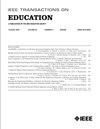学生辅导课电磁学中的互动与学习
IF 2
2区 工程技术
Q2 EDUCATION, SCIENTIFIC DISCIPLINES
引用次数: 0
摘要
贡献:本研究确定了通过学生主导的教程(slt)促进学生学习的互动类型。这些互动的质量包括同侪讨论、学生导师报告、联合推理和建设性反馈。背景:在高等电磁学学士课程中引入slt使通过率从40%提高到60%。slt作为同伴学习和辅导的一种类型,与主动学习和学生成绩相关。然而,关于不同类型的学生互动及其各自对学习的影响的知识并不多。研究问题:学生的互动如何有助于学生对电磁学内容的理解和解决问题的技能,以及影响这种互动质量的因素是什么?设计/方法:本研究归纳分析了不同的数据来源,包括课堂观察、学生调查、焦点小组和访谈,以确定slt的相互作用。研究发现:slt有助于学生理解概念,练习一般工程问题解决技能,并与课程活动保持同步。学生报告的质量,导师提出的问题类型,在更广泛的范围内修改所有问题与深入讨论概念之间的紧张关系,内容知识的难度以及导师对问题的理解;影响SLT相互作用的质量。本研究发现,在总体上语言辅助教学促进学习的同时,教授学生如何积极参与,培训助教如何组织课堂互动,可以进一步促进对主题的深入概念讨论。本文章由计算机程序翻译,如有差异,请以英文原文为准。
Student-Led Tutorials Interactions and Learning in Electromagnetism
Contribution: This study identifies the types of interaction that contribute to student learning with student-led tutorials (SLTs). The quality of these interactions include peer discussion, student tutor presentation, joint reasoning, and constructive feedback.Background: The introduction of SLTs in an advanced electromagnetics bachelor course has improved the passing rates from 40% to 60%. SLTs, as one type of peer learning and tutoring, correlate with active learning and student achievement. However, there is not much knowledge about the different kinds of student interactions and its respective impact on learning.Research Question: How students’ interactions contribute to students understanding of content and problem-solving skills in electromagnetism and what influences the quality of such interactions?Design/Method: The study inductively analyzed different sources of data that included classroom observations, student surveys, focus groups, and interviews to identify SLTs interactions.Findings: SLTs contributed to student understanding of concepts, practicing general engineering problem-solving skills, and keeping pace with the course activities. The quality of students’ presentations, the type of questions that tutors posed, the tension between revising all problems in broader terms and discussing concepts in-depth, the difficulty of content knowledge and tutors’ understanding of the problems; influenced the quality of SLT interactions. This research finds that, while in general SLT promotes learning, teaching students how to actively participate and training teaching assistants how to organize classroom interactions, can further contribute to in-depth conceptual discussions of the subject matter.
求助全文
通过发布文献求助,成功后即可免费获取论文全文。
去求助
来源期刊

IEEE Transactions on Education
工程技术-工程:电子与电气
CiteScore
5.80
自引率
7.70%
发文量
90
审稿时长
1 months
期刊介绍:
The IEEE Transactions on Education (ToE) publishes significant and original scholarly contributions to education in electrical and electronics engineering, computer engineering, computer science, and other fields within the scope of interest of IEEE. Contributions must address discovery, integration, and/or application of knowledge in education in these fields. Articles must support contributions and assertions with compelling evidence and provide explicit, transparent descriptions of the processes through which the evidence is collected, analyzed, and interpreted. While characteristics of compelling evidence cannot be described to address every conceivable situation, generally assessment of the work being reported must go beyond student self-report and attitudinal data.
 求助内容:
求助内容: 应助结果提醒方式:
应助结果提醒方式:


